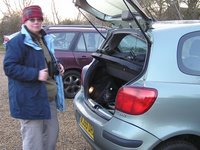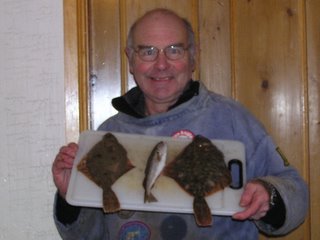North Norfolk Coast
After a hearty breakfast (Jan 28th) we were at the Cley East Bank at sunrise with clear skies and a bitter Siberian wind blowing off the sea, in time to see skein after skein of Brent Geese lifting off and heading for feeding grounds, whilst a Sparrowhawk circled over the wood. A walk along the bank to the sea revealed various waterfowl (including Little Grebe and Pintail), several wader species (Black and Bar-tailed Godwits, Spotted Redshank, Grey and Golden Plover, Knot, etc.), a fine female Marsh Harrier and a Little Egret.

Pam with her sparkly new Yaris on its maiden voyage
On then to the RSPB reserve at Titchwell, always a reliable location for a good diversity of birds. We snatched a bite to eat and, before exploring the reserve itself, diverted a mile or so to Choseley Barns, which have a reputation for attracting throngs of graminivorous species, including (it is alleged) Lapland Buntings. With mile after mile of stubble fields stretching to the horizon, it seemed like looking for the eponymous needle in the haystack, so a prompt return to Tichwell was agreed. This reserve never fails and we found here additionally Goldeneye, Egyptian Goose, Avocet, Ruff, Turnstone and on the beach Sandlerlings were running about like clockwork toys. On the sea Red-throated Diver, Red-breasted Merganser, and Great Crested Grebe were spotted as they rose to the peaks of the waves. Here too was seen the day's highlight, as a flock of some 200 Common Scoter turned head to wind to land on the sea straight in front of us, showing clearly their open wings in direct sunshine. Some six or so had the tell-tale white wing-bar, diagnostic of the much scarcer Velvet Scoter. A British 'tick' for Pam and an English one for me.
With the sun setting fast and the light failing, thoughts turned homeward bound, but not before a quick call to the cliffs at Old Hunstanton where 4 or 5 Fulmars (Maalies) were a splendid conclusion to the day. Except that I added a sneaky two more species (Kestrel and Green Woodpecker) to the day's tally of 79 while driving home.
List of bird species recorded during the day.
1.Brent Goose; 2.Sparrowhawk; 3.Golden Plover; 4.Lapwing; 5.Coot; 6.Mallard; 7.Little Grebe; 8.Black-tailed Godwit; 9.Pintail; 10.Wigeon; 11.Marsh Harrier; 12.Cormorant; 13.Black-headed Gull; 14.Shelduck; 15.Redshank; 16.Dunlin; 17.Grey Plover; 18.Knot; 19.Oystercatcher; 20.Curlew; 21.Gadwall; 22.Spotted Redshank; 23.Bar-tailed Godwit; 24.Snipe; 25.Lesser Black-backed Gull; 26.Common Gull; 27.Herring Gull; 28.Shoveller; 29.Ringed Plover; 30.Teal; 31.Tufted Duck; 32.Greylag Goose; 33.Woodpigeon; 34.Reed Bunting; 35.Moorhen; 36.House Sparrow; 37.Blackbird; 38.Collared Dove; 39.Jackdaw; 40.Starling; 41.Robin; 42.Pink-footed Goose; 43.Coal Tit; 44.Jay;45.Rock Pipit; 46.Snow Bunting; 47.Skylark; 48.Shorelark; 49.Pheasant; 50.Magpie; 51.Carrion Crow; 52.Great Tit; 53.Mute Swan; 54.Mistle Thrush; 55.Fieldfare; 56.Little Egret; 57.Dunnock; 58.Greenfinch; 59.Wren; 60.Pochard; 61.Red-throated Diver; 62.Red-breasted Merganser; 63.Common Scoter; 64.Velvet Scoter; 65.Avocet; 66.Turnstone; 67.Ruff; 68.Canada Goose; 69.Egyptian Goose; 70.Goldeneye; 71.Sanderling; 72.Chaffinch; 73.Goldfinch; 74.Great Crested Grebe; 75.Grey Heron; 76.Blue Tit; 77.Fulmar; 78.Kestrel; 79.Green Woodpecker.





